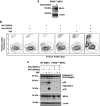TNF can activate RIPK3 and cause programmed necrosis in the absence of RIPK1
- PMID: 23328672
- PMCID: PMC3563989
- DOI: 10.1038/cddis.2012.201
TNF can activate RIPK3 and cause programmed necrosis in the absence of RIPK1
Abstract
Ligation of tumor necrosis factor receptor 1 (TNFR1) can cause cell death by caspase 8 or receptor-interacting protein kinase 1 (RIPK1)- and RIPK3-dependent mechanisms. It has been assumed that because RIPK1 bears a death domain (DD), but RIPK3 does not, RIPK1 is necessary for recruitment of RIPK3 into signaling and death-inducing complexes. To test this assumption, we expressed elevated levels of RIPK3 in murine embryonic fibroblasts (MEFs) from wild-type (WT) and gene-deleted mice, and exposed them to TNF. Neither treatment with TNF nor overexpression of RIPK3 alone caused MEFs to die, but when levels of RIPK3 were increased, addition of TNF killed WT, Ripk1(-/-), caspase 8(-/-), and Bax(-/-)/Bak(-/-) MEFs, even in the presence of the broad-spectrum caspase inhibitor Q-VD-OPh. In contrast, Tnfr1(-/-) and Tradd(-/-) MEFs did not die. These results show for the first time that in the absence of RIPK1, TNF can activate RIPK3 to induce cell death both by a caspase 8-dependent mechanism and by a separate Bax/Bak- and caspase-independent mechanism. RIPK1 is therefore not essential for TNF to activate RIPK3 to induce necroptosis nor for the formation of a functional ripoptosome/necrosome.
Figures







Similar articles
-
Necroptosis induced by RIPK3 requires MLKL but not Drp1.Cell Death Dis. 2014 Feb 27;5(2):e1086. doi: 10.1038/cddis.2014.18. Cell Death Dis. 2014. PMID: 24577084 Free PMC article.
-
RIPK1 prevents TRADD-driven, but TNFR1 independent, apoptosis during development.Cell Death Differ. 2019 May;26(5):877-889. doi: 10.1038/s41418-018-0166-8. Epub 2018 Sep 5. Cell Death Differ. 2019. PMID: 30185824 Free PMC article.
-
TRADD regulates perinatal development and adulthood survival in mice lacking RIPK1 and RIPK3.Nat Commun. 2019 Feb 11;10(1):705. doi: 10.1038/s41467-019-08584-5. Nat Commun. 2019. PMID: 30741936 Free PMC article.
-
RIPK1 and RIPK3: critical regulators of inflammation and cell death.Trends Cell Biol. 2015 Jun;25(6):347-53. doi: 10.1016/j.tcb.2015.01.001. Epub 2015 Feb 4. Trends Cell Biol. 2015. PMID: 25662614 Review.
-
Necroptosis and Inflammation.Annu Rev Biochem. 2016 Jun 2;85:743-63. doi: 10.1146/annurev-biochem-060815-014830. Epub 2016 Feb 8. Annu Rev Biochem. 2016. PMID: 26865533 Review.
Cited by
-
Aging and uremia: Is there cellular and molecular crossover?World J Nephrol. 2015 Feb 6;4(1):19-30. doi: 10.5527/wjn.v4.i1.19. World J Nephrol. 2015. PMID: 25664244 Free PMC article. Review.
-
Molecular Pathogenesis of NASH.Int J Mol Sci. 2016 Sep 20;17(9):1575. doi: 10.3390/ijms17091575. Int J Mol Sci. 2016. PMID: 27657051 Free PMC article. Review.
-
Necroptosis: Fifty shades of RIPKs.Mol Cell Oncol. 2014 Nov 7;2(2):e965638. doi: 10.4161/23723548.2014.965638. eCollection 2015 Apr-Jun. Mol Cell Oncol. 2014. PMID: 27308415 Free PMC article.
-
Sox2 overexpression alleviates noise-induced hearing loss by inhibiting inflammation-related hair cell apoptosis.J Neuroinflammation. 2022 Feb 28;19(1):59. doi: 10.1186/s12974-022-02414-0. J Neuroinflammation. 2022. PMID: 35227273 Free PMC article.
-
Necroptosis induced by RIPK3 requires MLKL but not Drp1.Cell Death Dis. 2014 Feb 27;5(2):e1086. doi: 10.1038/cddis.2014.18. Cell Death Dis. 2014. PMID: 24577084 Free PMC article.
References
-
- Baud V, Karin M. Signal transduction by tumor necrosis factor and its relatives. Trends Cell Biol. 2001;11:372–377. - PubMed
-
- Laster SM, Wood JG, Gooding LR. Tumor necrosis factor can induce both apoptic and necrotic forms of cell lysis. J Immunol. 1988;141:2629–2634. - PubMed
-
- Beg AA, Baltimore D. An essential role for Nf-Kappa-B in preventing Tnf-alpha-induced cell death. Science. 1996;274:782–784. - PubMed
-
- Chinnaiyan AM, Tepper CG, Seldin MF, Orourke K, Kischkel FC, Hellbardt S, et al. Fadd/mort1 is a common mediator of cd95 (fas/apo-1) and tumor necrosis factor receptor-induced apoptosis. J Biol Chem. 1996;271:4961–4965. - PubMed
Publication types
MeSH terms
Substances
LinkOut - more resources
Full Text Sources
Other Literature Sources
Research Materials
Miscellaneous

